Quality Assessment of Global Ocean Island Datasets
Abstract
:1. Introduction
1.1. Related Works
1.2. Aim and Contributions
- (1)
- Different measures (including accuracy, completeness and shape complexity) were designed for assessing the data quality of island datasets.
- (2)
- Both the GSV and OSM datasets were not only assessed but also compared, in order to investigate which performed the best.
1.3. Organization
2. Study Area and Data
2.1. Study Area
2.2. Data
- Global shoreline vector (GSV): The dataset is a 30-m spatial resolution global shoreline vector, which was produced based on annual composites of 2014 Landsat satellite images [22]. This dataset includes 340,691 islands in total, divided into three classes, i.e., 5 continental mainlands, 21,818 big islands greater than 1 km2 and 318,868 islands smaller than 1 km2 (Table 2). The dataset was acquired on 27 April 2021 from the website https://rmgsc.cr.usgs.gov/gie.
- OpenStreetMap (OSM): The dataset were freely acquired from Planet OSM: https://planet.openstreetmap.org/ (accessed on 13 February 2023), acquired in 2021. The platform provides all OSM data on a global scale. Each object in OSM has at least one tag (consisting of a key and a value) to describe the attribute of this object. As an example, if an OSM object is tagged with “place (key) = islet (value)”, it means that this object is a small island in the sea. Moreover, in our study, three different tags (i.e., natural = coastline, place = island and place = islet) relating to islands were extracted from OSM data (Table 2). In addition, the extracted data, originally saved in a pdf format, were converted into a shapefile format for the analysis, because the latter format can be processed by most geographic information system (GIS) software (e.g., ArcGIS and QGIS).
3. Methodology
3.1. Accuracy
- First, a set of sampling points with an interval of 2 km was acquired from each study area, resulting in a total of 2500 sampling points for each study area.
- Next, the reference classification of each sampling point (either ‘island’ or ‘non-island’) was visually interpreted from the corresponding satellite image in Google Earth, which was taken around the year 2021.
- Subsequently, all sampling points for each study area were overlaid on each open dataset (e.g., GSV or OSM) to determine the predicted classification (either ‘island’ or ‘non-island’) of each sampling point. Specifically, if a sampling point was located within the polygon of an island, it was classified as ‘island’; otherwise, it was classified as ‘non-island’.
- Finally, the predicted classification of each sampling point was compared with the corresponding reference classification, using four different measures: overall accuracy (OA), precision, recall, and F1. These measures were chosen because they have been widely used to evaluate the performance of classification problems [37,38].
3.2. Completeness
3.3. Shape Complexity
- First, the islands in each dataset (GSV or OSM), which were originally represented by polygons, were converted into lines (or boundaries).
- Then, the lines or boundaries in each dataset and each study area (i.e., I, II, III or IV) were respectively overlaid with regular grids of different sizes (i.e., 10, 30, 50, 100, 300, 500 and 1000 m, Figure 3). For each grid cell, not only was the size of the grid cell (r) recorded but also the number of grid cells that intersected with a line or boundary (Nr) was calculated.
- After that, the natural logarithms of each pair of r and Nr were calculated. That means each pair of r and Nr was converted into In(r) and In(Nr), respectively.
- Lastly, a linear function was used to fit multiple pairs of In(r) and In(Nr) of different grid sizes, that is,
4. Results and Analyses
4.1. Results of Accuracy
- (1)
- The overall accuracy (OA) is almost 100% for both datasets (GSV and OSM), and even the lowest OA value is higher than 98%. This indicates the effectiveness of using the two datasets for mapping islands. Moreover, for two out of the four study areas, the OA is slightly higher for the GSV dataset than for the OSM dataset. However, this is the opposite case for study area IV, which suggests that performance may vary with different study areas.
- (2)
- In most cases, precision is higher for the OSM dataset. Taking study area III as an example, precision is 93.40% for the OSM dataset, which is higher than that (90.83%) for the GSV dataset. Despite this, most precision values are higher than 90%, indicating that most sampling points identified as ‘island’ in these island datasets have also been classified as ‘island’ when referring to Google Earth.
- (3)
- Unlike precision, recall values are higher for the GSV dataset than for the OSM dataset in most cases. Taking study area I as an example, the recall value is only 81.82% for the OSM dataset, which is much lower than that (90%) for the GSV dataset. Despite this, all recall values are higher than 90%, indicating that most sampling points classified as ‘island’ in Google Earth have also been identified as ‘island’ in these island datasets.
- (4)
- The best performance of the two island datasets also varies with different study areas in terms of F1. Specifically, the GSV dataset performs better than the OSM dataset for study areas I and II, but this is the opposite case for study area IV.
4.2. Results of Completeness
4.3. Results of Shape Complexity
5. Discussion
5.1. Comparing between GSV and OSM Datasets
5.2. Applications
5.3. Limitations
6. Conclusions
- (1)
- The best performance between the two island datasets (GSV and OSM) varied with different study areas in terms of OA and F1. In most cases, the OSM dataset performed better in terms of precision, but GSV performed better with respect to recall.
- (2)
- Area completeness is close to 100%, indicating that both the GSV and OSM datasets are similar in terms of the total area of islands. However, count completeness was much higher than 100%, indicating that the OSM dataset is larger than the GSV dataset in terms of the total number of islands. Likewise, more small islands can be acquired from the OSM dataset.
- (3)
- In most cases, the OSM dataset has a higher value than the GSV dataset in terms of shape complexity (or fractal dimension), indicating that the OSM dataset has more details in terms of the island boundary or coastline.
Author Contributions
Funding
Data Availability Statement
Acknowledgments
Conflicts of Interest
Appendix A
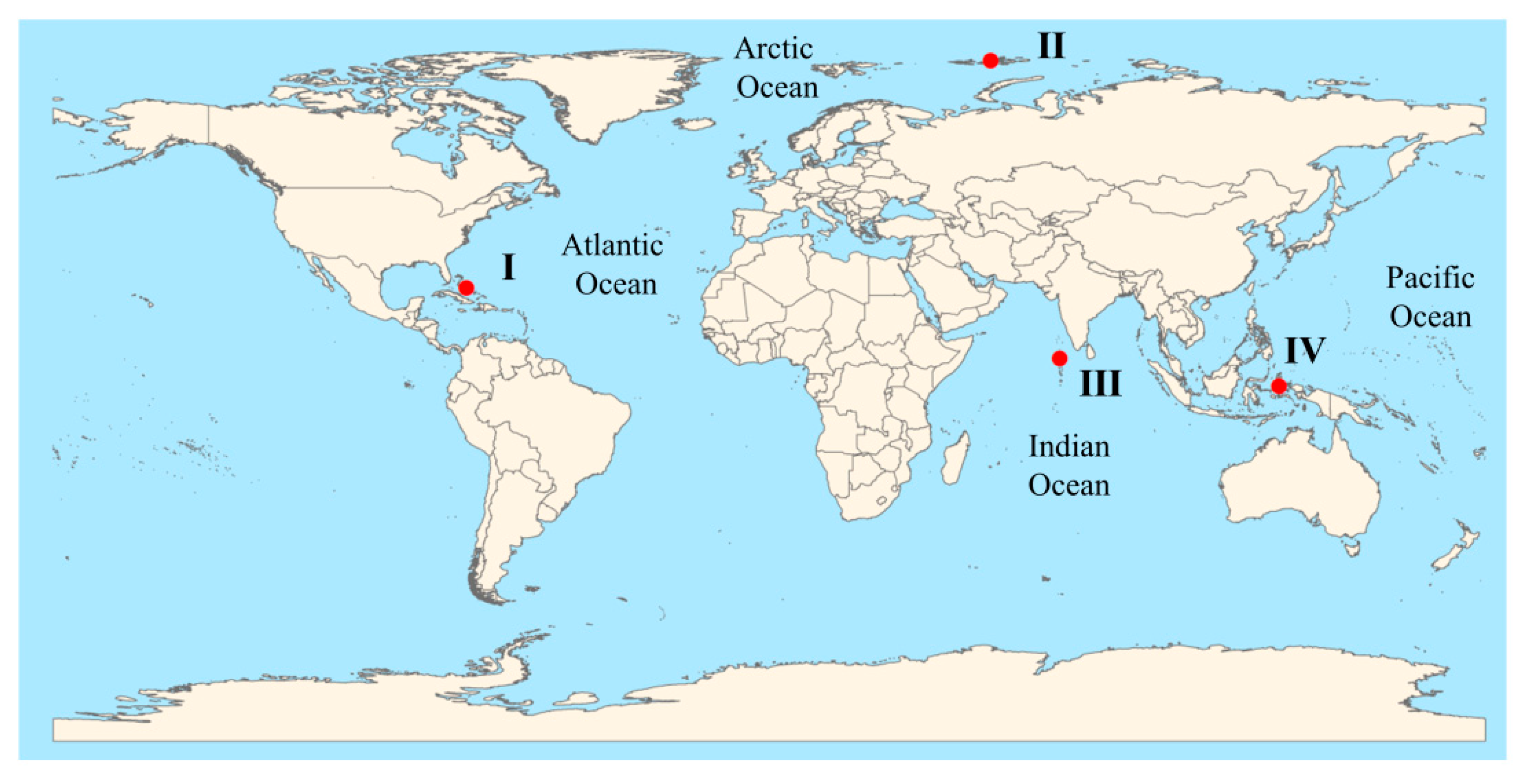
Appendix B
| Study Area | Overall Accuracy (%) | Precision (%) | Recall (%) | F1 | ||||
|---|---|---|---|---|---|---|---|---|
| GSV | OSM | GSV | OSM | GSV | OSM | GSV | OSM | |
| I | 99.64 | 99.48 | 95.24 | 98.18 | 90.91 | 81.82 | 0.93 | 0.89 |
| II | 98.40 | 98.24 | 96.65 | 96.75 | 98.54 | 97.93 | 0.98 | 0.97 |
| III | 99.96 | 99.96 | 100.00 | 100.00 | 93.33 | 93.33 | 0.97 | 0.97 |
| IV | 99.48 | 99.60 | 90.83 | 93.40 | 97.06 | 97.06 | 0.94 | 0.95 |
References
- Royle, S.A. A human geography of islands. Geography 1989, 74, 106–116. [Google Scholar]
- Spalding, M.D.; Ruffo, S.; Lacambra, C.; Meliane, I.; Hale, L.Z.; Shepard, C.C.; Beck, M.W. The role of ecosystems in coastal protection: Adapting to climate change and coastal hazards. Ocean Coast. Manag. 2014, 90, 50–57. [Google Scholar] [CrossRef]
- Mimura, N. Vulnerability of island countries in the South Pacific to sea level rise and climate change. Clim. Res. 1999, 12, 137–143. [Google Scholar] [CrossRef]
- Harter, D.E.; Irl, S.D.; Seo, B.; Steinbauer, M.J.; Gillespie, R.; Triantis, K.A.; Fernández-Palacios, J.-M.; Beierkuhnlein, C. Impacts of global climate change on the floras of oceanic islands–Projections, implications and current knowledge. Perspect. Plant Ecol. Evol. Syst. 2015, 17, 160–183. [Google Scholar] [CrossRef]
- Amores, A.; Marcos, M.; Le Cozannet, G.; Hinkel, J. Coastal flooding and mean sea-level rise allowances in atoll island. Sci. Rep. 2022, 12, 1281. [Google Scholar] [CrossRef]
- Pelling, M.; Uitto, J.I. Small island developing states: Natural disaster vulnerability and global change. Glob. Environ. Change Part B Environ. Hazards 2001, 3, 49–62. [Google Scholar] [CrossRef]
- Noy, I. Natural disasters in the Pacific Island Countries: New measurements of impacts. Nat. Hazards 2016, 84 (Suppl. S1), 7–18. [Google Scholar] [CrossRef]
- Hasan, M.H. Destruction of a Holothuria scabra population by overfishing at Abu Rhamada Island in the Red Sea. Mar. Environ. Res. 2005, 60, 489–511. [Google Scholar] [CrossRef]
- Wairiu, M. Land degradation and sustainable land management practices in Pacific Island Countries. Reg. Environ. Change 2017, 17, 1053–1064. [Google Scholar] [CrossRef]
- Zhang, Y.; Li, D.; Fan, C.; Xu, H.; Hou, X. Southeast Asia island coastline changes and driving forces from 1990 to 2015. Ocean Coast. Manag. 2021, 215, 105967. [Google Scholar] [CrossRef]
- Virto, L.R. A preliminary assessment of the indicators for Sustainable Development Goal (SDG) 14 “Conserve and sustainably use the oceans, seas and marine resources for sustainable development”. Mar. Policy 2018, 98, 47–57. [Google Scholar] [CrossRef]
- Dong, Y.; Liu, Y.; Hu, C.; Xu, B. Coral reef geomorphology of the Spratly Islands: A simple method based on time-series of Landsat-8 multi-band inundation maps. ISPRS J. Photogramm. Remote Sens. 2019, 157, 137–154. [Google Scholar] [CrossRef]
- Immordino, F.; Barsanti, M.; Candigliota, E.; Cocito, S.; Delbono, I.; Peirano, A. Application of Sentinel-2 multispectral data for habitat mapping of Pacific islands: Palau Republic (Micronesia, Pacific Ocean). J. Mar. Sci. Eng. 2019, 7, 316. [Google Scholar] [CrossRef] [Green Version]
- Lyons, M.B.; MRoelfsema, C.; VKennedy, E.; MKovacs, E.; Borrego-Acevedo, R.; Markey, K.; Roe, M.; Yuwono, D.M.; Harris, D.L.; Phinn, S.R.; et al. Mapping the world’s coral reefs using a global multiscale earth observation framework. Remote Sens. Ecol. Conserv. 2020, 6, 557–568. [Google Scholar] [CrossRef] [Green Version]
- Zhuang, Q.; Zhang, J.; Cheng, L.; Chen, H.; Song, Y.; Chen, S.; Chu, S.; Dongye, S.; Li, M. Framework for Automatic Coral Reef Extraction Using Sentinel-2 Image Time Series. Mar. Geod. 2022, 45, 195–231. [Google Scholar] [CrossRef]
- Mikelsons, K.; Wang, M.; Wang, X.L.; Jiang, L. Global land mask for satellite ocean color remote sensing. Remote Sens. Environ. 2021, 257, 112356. [Google Scholar] [CrossRef]
- Král, K.; Pavliš, J. The first detailed land-cover map of Socotra Island by Landsat/ETM+ data. Int. J. Remote Sens. 2006, 27, 3239–3250. [Google Scholar] [CrossRef]
- Révillion, C.; Attoumane, A.; Herbreteau, V. Homisland-IO: Homogeneous land use/land cover over the Small Islands of the Indian Ocean. Data 2019, 4, 82. [Google Scholar] [CrossRef] [Green Version]
- Chen, H.; Chen, C.; Zhang, Z.; Lu, C.; Wang, L.; He, X.; Chu, Y.; Chen, J. Changes of the spatial and temporal characteristics of land-use landscape patterns using multi-temporal Landsat satellite data: A case study of Zhoushan Island, China. Ocean Coast. Manag. 2021, 213, 105842. [Google Scholar] [CrossRef]
- Holdaway, A.; Ford, M.; Owen, S. Global-scale changes in the area of atoll islands during the 21st century. Anthropocene 2021, 33, 100282. [Google Scholar] [CrossRef]
- Leihy, R.I.; Duffy, G.A.; Nortje, E.; Chown, S.L. High resolution temperature data for ecological research and management on the Southern Ocean Islands. Sci. Data 2018, 5, 180177. [Google Scholar] [CrossRef] [Green Version]
- Sayre, R.; Noble, S.; Hamann, S.; Smith, R.; Wright, D.; Breyer, S.; Butler, K.; Van Graafeiland, K.; Frye, C.; Karagulle, D.; et al. A new 30 meter resolution global shoreline vector and associated global islands database for the development of standardized ecological coastal units. J. Oper. Oceanogr. 2019, 12 (Suppl. S2), S47–S56. [Google Scholar] [CrossRef] [Green Version]
- Mooney, P.; Minghini, M. A review of OpenStreetMap data. In Mapping and the Citizen Sensor; Ubiquity Press: London, UK, 2017; pp. 37–59. [Google Scholar]
- Neis, P.; Zipf, A. Analyzing the contributor activity of a volunteered geographic information project—The case of OpenStreetMap. ISPRS Int. J. Geo-Inf. 2012, 1, 146–165. [Google Scholar] [CrossRef] [Green Version]
- Neis, P.; Zielstra, D. Recent developments and future trends in volunteered geographic information research: The case of OpenStreetMap. Future Internet 2014, 6, 76–106. [Google Scholar] [CrossRef] [Green Version]
- Girres, J.F.; Touya, G. Quality assessment of the French OpenStreetMap dataset. Trans. GIS 2010, 14, 435–459. [Google Scholar] [CrossRef]
- Barrington-Leigh, C.; Millard-Ball, A. The world’s user-generated road map is more than 80% complete. PLoS ONE 2017, 12, e0180698. [Google Scholar] [CrossRef] [Green Version]
- Borkowska, S.; Pokonieczny, K. Analysis of OpenStreetMap data quality for selected counties in Poland in terms of sustainable development. Sustainability 2022, 14, 3728. [Google Scholar] [CrossRef]
- Tian, Y.; Zhou, Q.; Fu, X. An analysis of the evolution, completeness and spatial patterns of OpenStreetMap building data in China. ISPRS Int. J. Geo-Inf. 2019, 8, 35. [Google Scholar] [CrossRef] [Green Version]
- Zhang, Y.; Zhou, Q.; Brovelli, M.A.; Li, W. Assessing OSM building completeness using population data. Int. J. Geogr. Inf. Sci. 2022, 36, 1443–1466. [Google Scholar] [CrossRef]
- Zhou, Q.; Zhang, Y.; Chang, K.; Brovelli, M.A. Assessing OSM building completeness for almost 13,000 cities globally. Int. J. Digit. Earth 2023, 15, 2400–2421. [Google Scholar] [CrossRef]
- Viana, C.M.; Encalada, L.; Rocha, J. The value of OpenStreetMap historical contributions as a source of sampling data for multi-temporal land use/cover maps. ISPRS Int. J. Geo-Inf. 2019, 8, 116. [Google Scholar] [CrossRef] [Green Version]
- Wang, S.; Zhou, Q.; Tian, Y. Understanding completeness and diversity patterns of OSM-based land-use and land-cover dataset in China. ISPRS Int. J. Geo-Inf. 2020, 9, 531. [Google Scholar] [CrossRef]
- Zhou, Q.; Wang, S.; Liu, Y. Exploring the accuracy and completeness patterns of global land-cover/land-use data in OpenStreetMap. Appl. Geogr. 2022, 145, 102742. [Google Scholar] [CrossRef]
- ISO 19157:2013; Geographic Information—Data Quality. International Organization for Standardization: Geneva, Switzerland, 2013.
- Husain, A.; Reddy, J.; Bisht, D.; Sajid, M. Fractal dimension of coastline of Australia. Sci. Rep. 2021, 11, 6304. [Google Scholar] [CrossRef] [PubMed]
- Liao, Y.; Zhou, Q.; Jing, X. A comparison of global and regional open datasets for urban greenspace mapping. Urban For. Urban Green. 2021, 62, 127132. [Google Scholar] [CrossRef]
- Zhou, Q.; Jing, X. Evaluation and Comparison of Open and High-Resolution LULC Datasets for Urban Blue Space Mapping. Remote Sens. 2022, 14, 5764. [Google Scholar] [CrossRef]
- Xu, J.; Zhang, Z.; Zhao, X.; Wen, Q.; Zuo, L.; Wang, X.; Yi, L. Spatial and temporal variations of coastlines in northern China (2000–2012). J. Geogr. Sci. 2014, 24, 18–32. [Google Scholar] [CrossRef]
- Tsou, M.C. Multi-target collision avoidance route planning under an ECDIS framework. Ocean Eng. 2016, 121, 268–278. [Google Scholar] [CrossRef]
- Gao, M.; Shi, G.; Li, W.; Wang, Y.; Liu, D. An improved genetic algorithm for island route planning. Procedia Eng. 2017, 174, 433–441. [Google Scholar] [CrossRef]
- Merrifield, M.S.; McClintock, W.; Burt, C.; Fox, E.; Serpa, P.; Steinback, C.; Gleason, M. MarineMap: A web-based platform for collaborative marine protected area planning. Ocean Coast. Manag. 2013, 74, 67–76. [Google Scholar] [CrossRef]
- Gaymer, C.F.; Stadel, A.V.; Ban, N.C.; Cárcamo, P.F.; Ierna, J., Jr.; Lieberknecht, L.M. Merging top-down and bottom-up approaches in marine protected areas planning: Experiences from around the globe. Aquatic Conservation Mar. Freshw. Ecosyst. 2014, 24, 128–144. [Google Scholar] [CrossRef]
- Noble, M.M.; Harasti, D.; Pittock, J.; Doran, B. Using GIS fuzzy-set modelling to integrate social-ecological data to support overall resilience in marine protected area spatial planning: A case study. Ocean Coast. Manag. 2021, 212, 105745. [Google Scholar] [CrossRef]
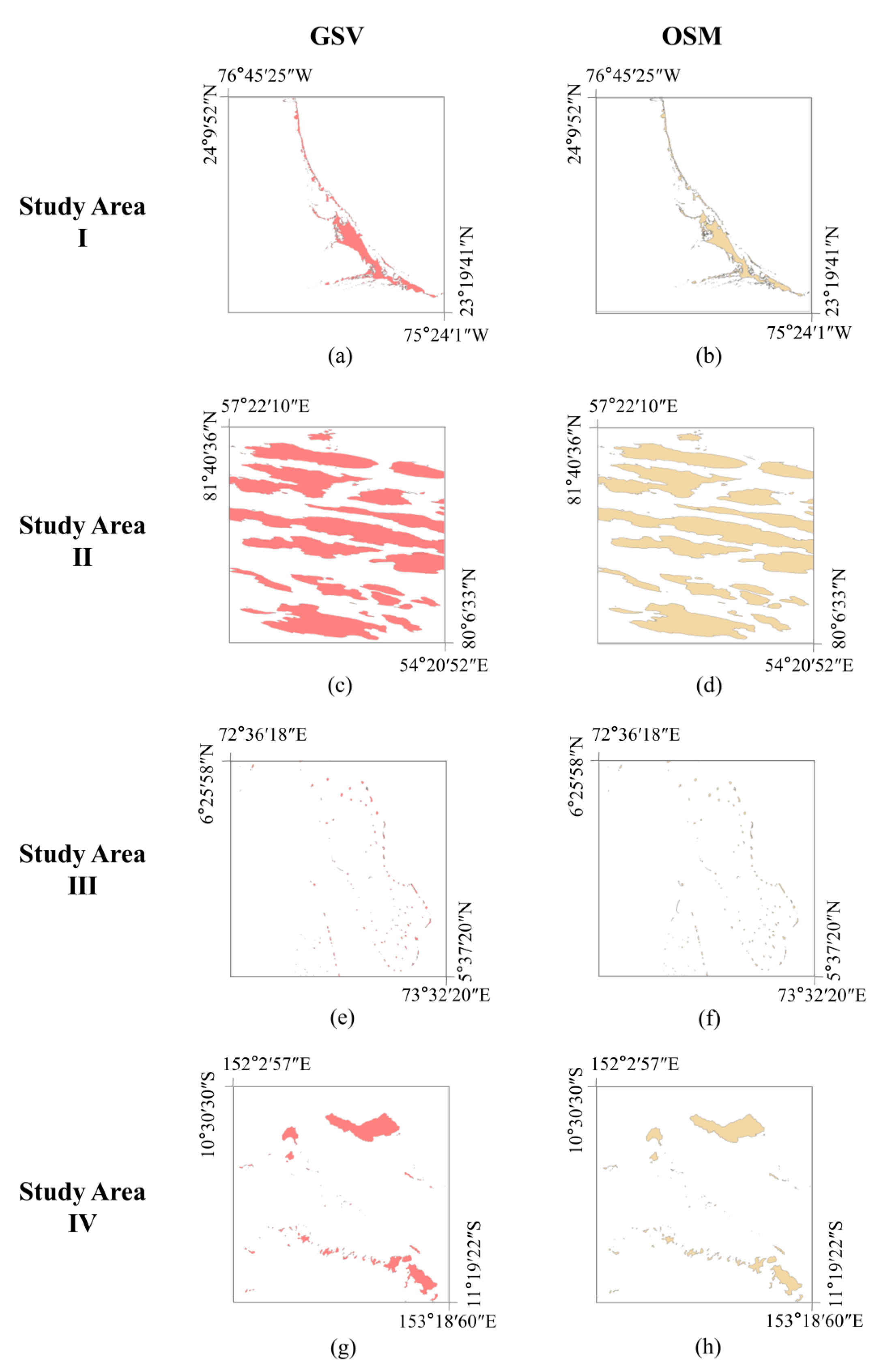
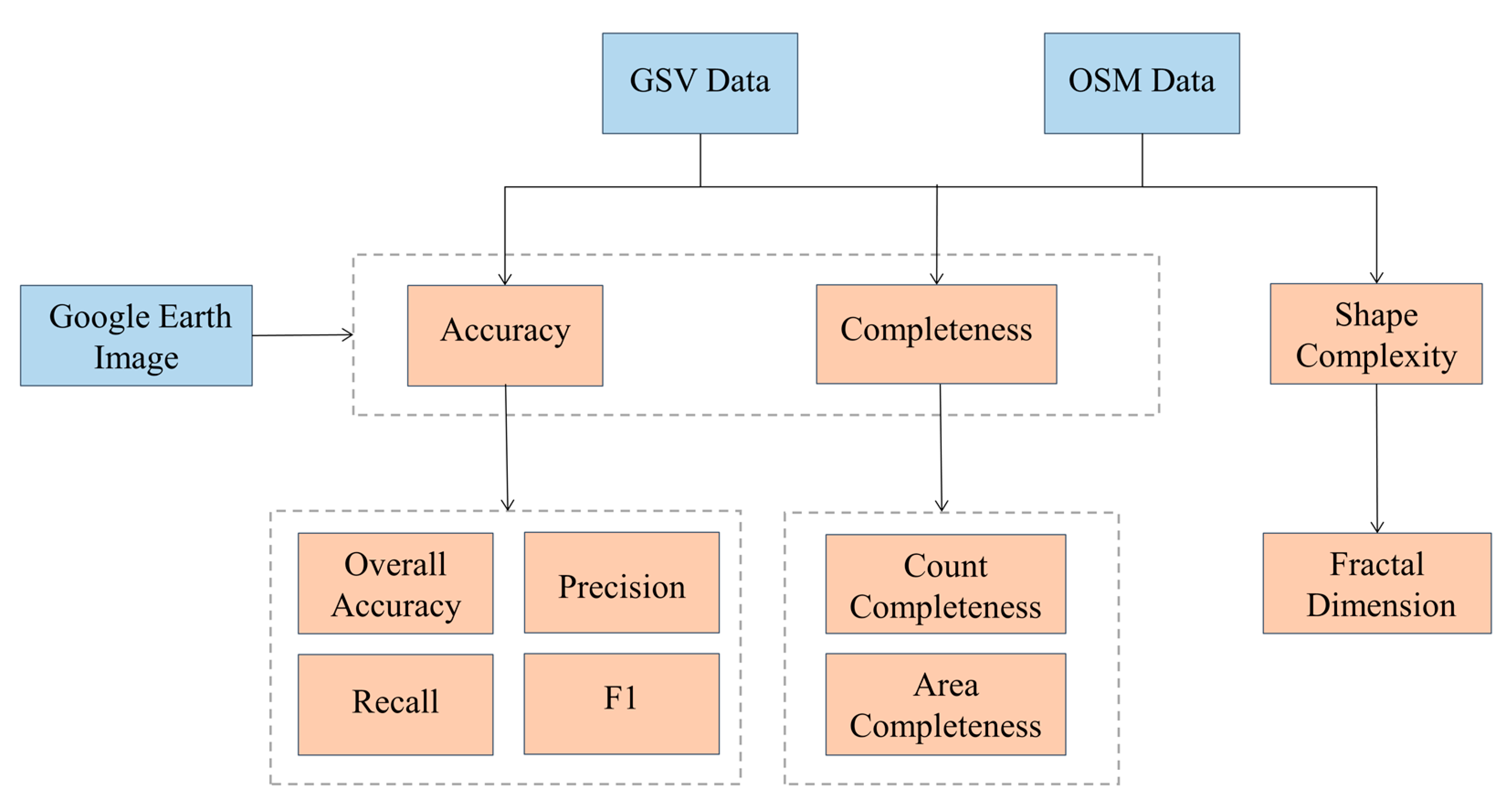

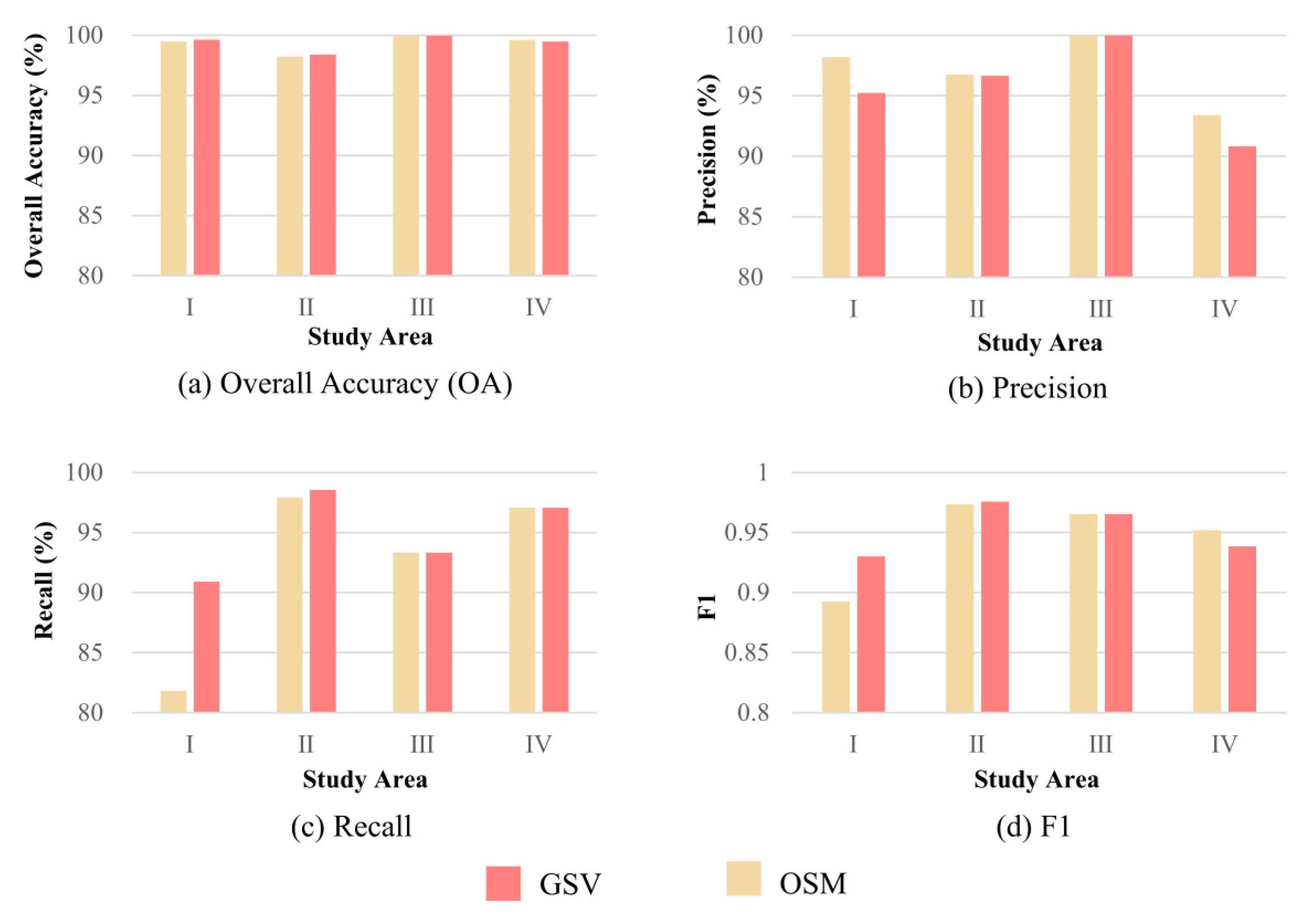
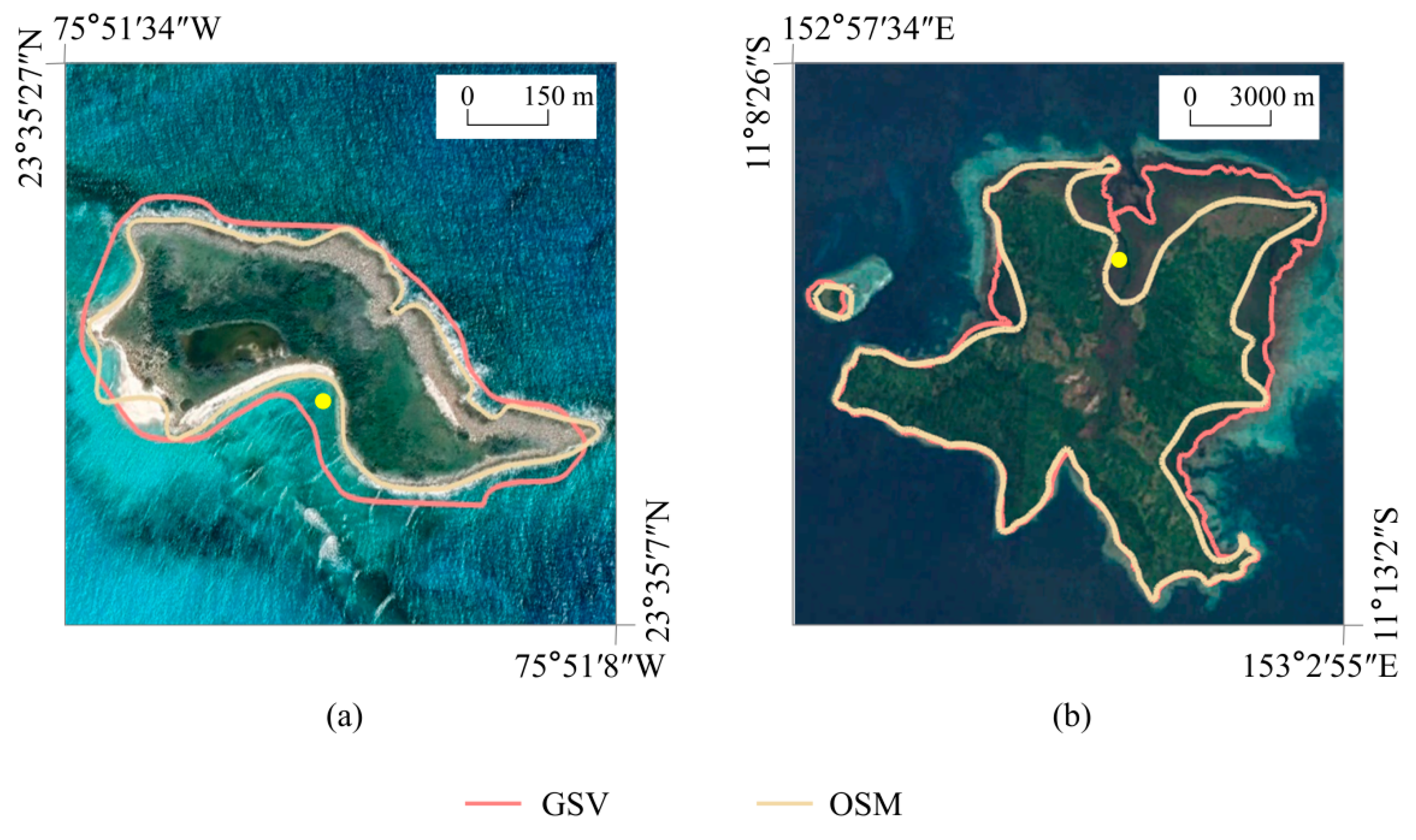


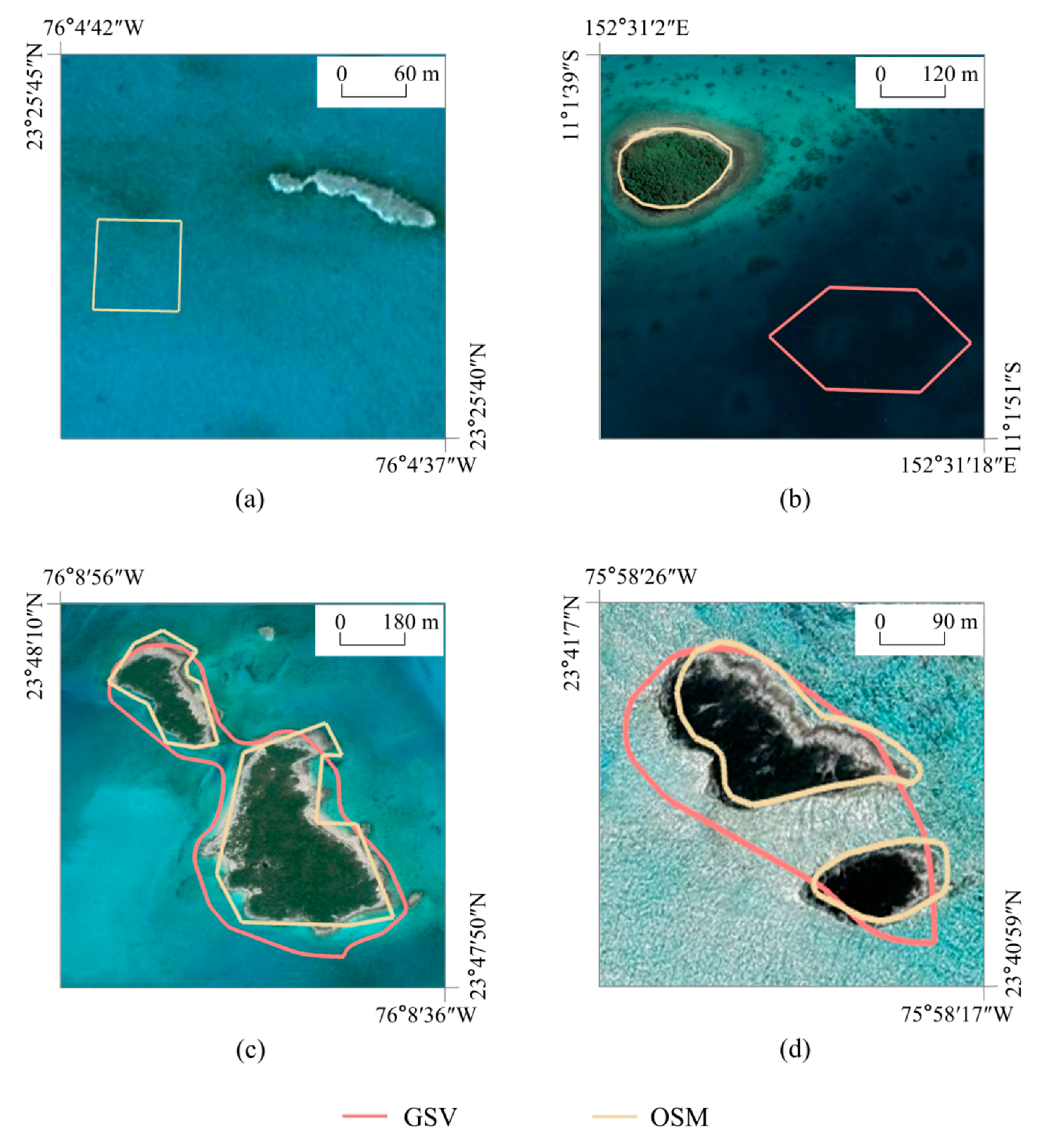
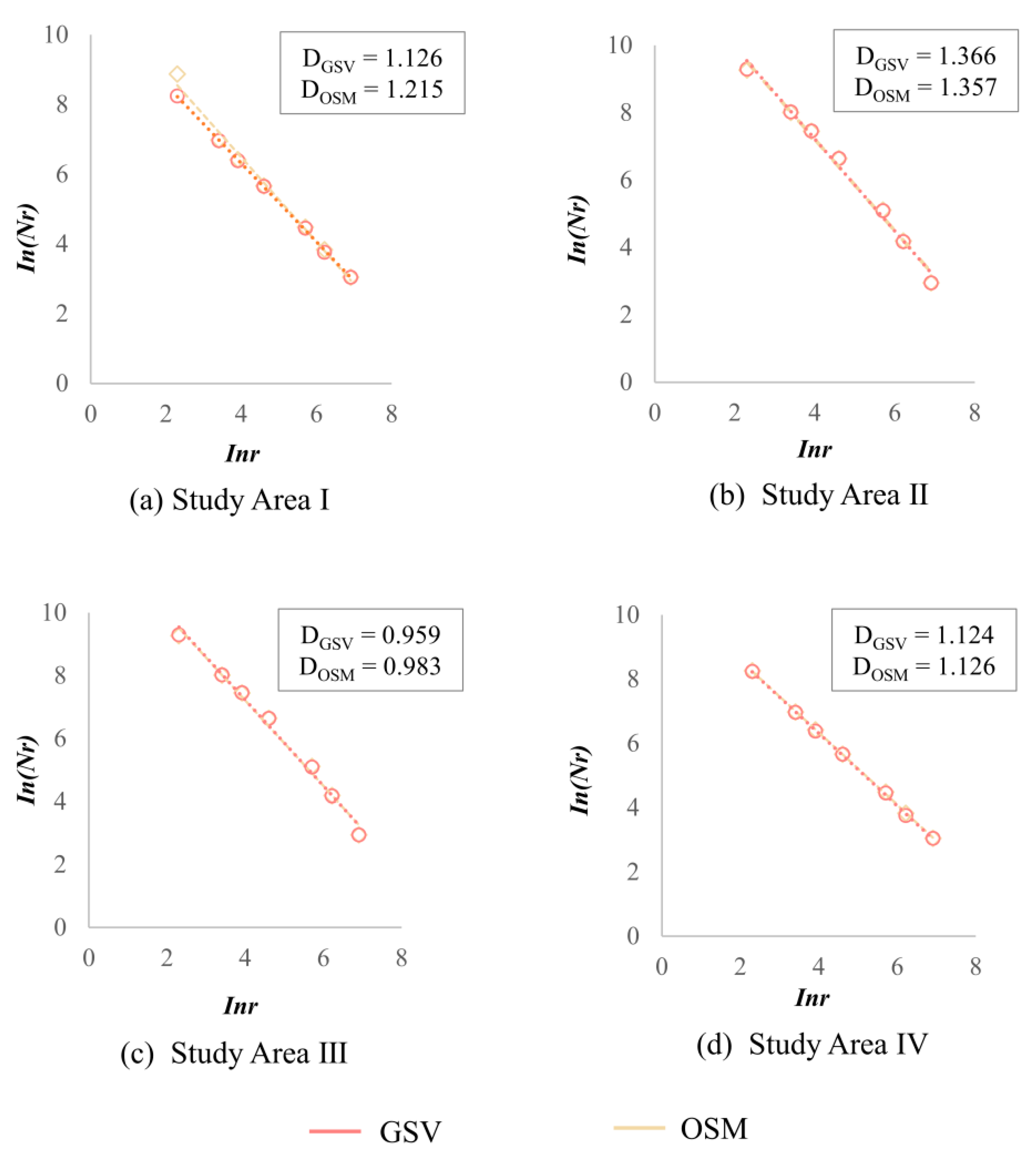
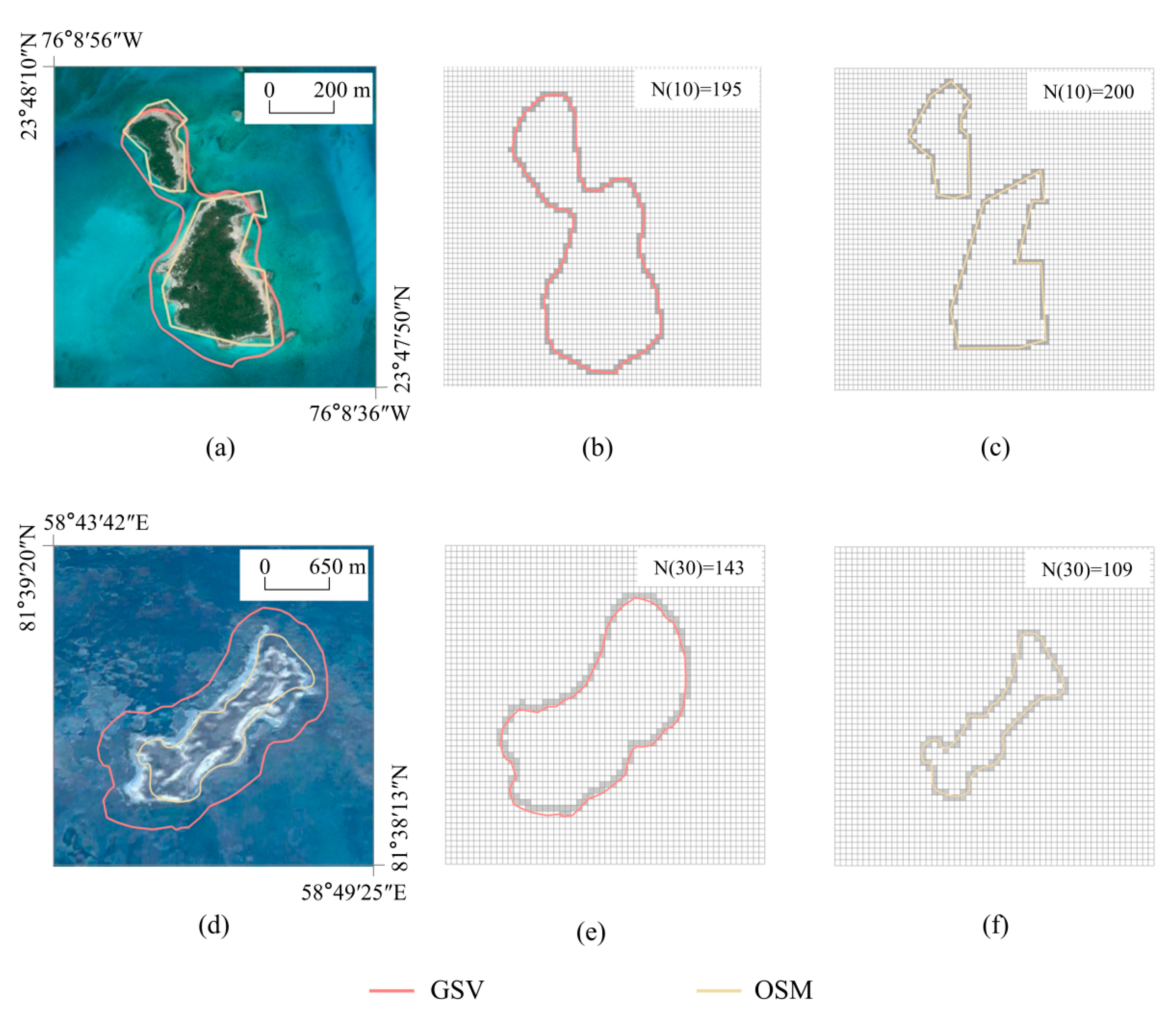
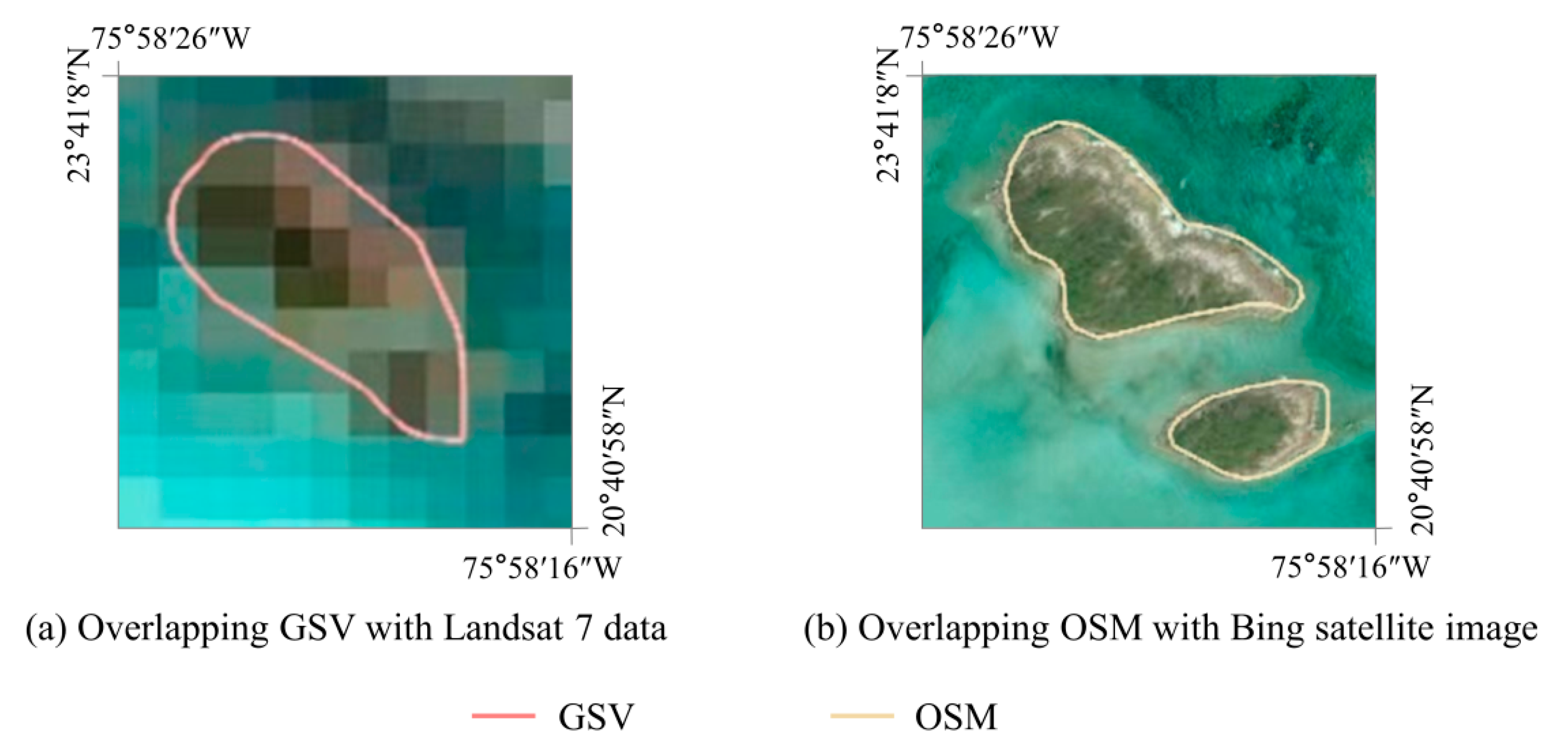
| Study Area | Geographical Region | Total Number of Islands | Average Size of Islands (m2) | ||
|---|---|---|---|---|---|
| GSV | OSM | GSV | OSM | ||
| I | Atlantic Ocean | 417 | 764 | 6.9 × 105 | 3.4 × 105 |
| II | Arctic Ocean | 56 | 73 | 5.9 × 107 | 4.5 × 107 |
| III | Indian Ocean | 151 | 172 | 2.5 × 105 | 2.4 × 105 |
| IV | Pacific Ocean | 115 | 136 | 3.7 × 106 | 3.0 × 107 |
| Dataset | Type/Tag | Definition |
|---|---|---|
| Global Shoreline Vector (GSV) | Continental mainlands | Northern America, Southern America, Africa, Australia, Eurasia |
| Large islands | Islands that are larger than 1 km2 | |
| Small islands | Islands that are smaller than 1 km2 | |
| OpenStreetMap (OSM) | natural = coastline | The mean high water springs line along the coastline at the edge of the sea |
| place = island | Any piece of land that is completely surrounded by water and isolated from other significant landmasses | |
| place = islet | Any very small island |
| Area Interval(m2) | I | II | III | IV | ||||
|---|---|---|---|---|---|---|---|---|
| GSV | OSM | GSV | OSM | GSV | OSM | GSV | OSM | |
| 0–102 | 0/0 | 23/25 | 0/0 | 0/0 | 0/0 | 0/0 | 0/0 | 0/0 |
| 102–302 | 20/23 | 113/116 | 0/0 | 0/0 | 1/2 | 6/7 | 0/0 | 1/1 |
| 302–502 | 27/28 | 151/154 | 0/0 | 0/0 | 6/7 | 9/9 | 0/0 | 7/7 |
| 502–1002 | 123/126 | 178/180 | 0/0 | 7/9 | 12/13 | 12/13 | 9/9 | 24/24 |
| 1002–10002 | 216/216 | 267/267 | 29/30 | 39/39 | 124/124 | 137/137 | 79/87 | 84/84 |
| >10002 | 24/24 | 22/22 | 26/26 | 25/25 | 5/5 | 6/6 | 19/19 | 20/20 |
Disclaimer/Publisher’s Note: The statements, opinions and data contained in all publications are solely those of the individual author(s) and contributor(s) and not of MDPI and/or the editor(s). MDPI and/or the editor(s) disclaim responsibility for any injury to people or property resulting from any ideas, methods, instructions or products referred to in the content. |
© 2023 by the authors. Licensee MDPI, Basel, Switzerland. This article is an open access article distributed under the terms and conditions of the Creative Commons Attribution (CC BY) license (https://creativecommons.org/licenses/by/4.0/).
Share and Cite
Chen, Y.; Zhao, S.; Zhang, L.; Zhou, Q. Quality Assessment of Global Ocean Island Datasets. ISPRS Int. J. Geo-Inf. 2023, 12, 168. https://doi.org/10.3390/ijgi12040168
Chen Y, Zhao S, Zhang L, Zhou Q. Quality Assessment of Global Ocean Island Datasets. ISPRS International Journal of Geo-Information. 2023; 12(4):168. https://doi.org/10.3390/ijgi12040168
Chicago/Turabian StyleChen, Yijun, Shenxin Zhao, Lihua Zhang, and Qi Zhou. 2023. "Quality Assessment of Global Ocean Island Datasets" ISPRS International Journal of Geo-Information 12, no. 4: 168. https://doi.org/10.3390/ijgi12040168







